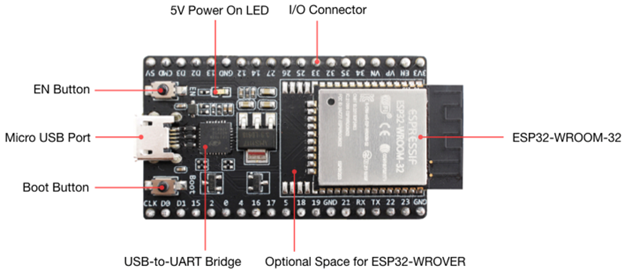The ESP32-DevKitC is a compact development board that utilizes the ESP32 microcontroller and is manufactured by Espressif. The board features pin headers on both sides, allowing for convenient interfacing with various peripherals. It can be connected to peripherals using jumper wires or mounted on a breadboard.
To cater to diverse user requirements, the ESP32-DevKitC V4 is available in various versions, each featuring a different ESP32 module such as:
- ESP32-WROOM-DA
- ESP32-WROOM-32E
- ESP32-WROOM-32UE
- ESP32-WROOM-32D
- ESP32-WROOM-32U
- ESP32-SOLO-1
- ESP32-WROVER-E
- ESP32-WROVER-IE
For details, please refer to ESP Product Selector.
Functional Description
The following figure and the table below describe the key components, interfaces, and controls of the ESP32-DevKitC V4 board:
| Key Component | Description |
| ESP32-WROOM-32
|
The chipset used in ESP32-DevKitC is ESP32-WROOM-32. It is the chip at the core of the board. More information about this chip can be found at ESP32-WROOM-32 Datasheet. |
| EN | Reset button |
| Boot | A download button (Boot) used in conjunction with EN to initiate firmware download mode using serial port. |
| USB-to-UART Bridge | A single USB-to-UART bridge chip that allows for transfer rates of up to 3 Mbps. |
| Micro USB Port | A Micro USB port that serves as both a power supply for the board and a communication interface between a computer and the ESP32-WROOM-32 module. |
| 5V Power On LED | There is a 5V power on LED that illuminates when the board is connected to a USB or an external 5V power supply. |
| I/O | Most of the pins on the ESP module are accessible through the pin headers on the board, allowing the ESP32 to perform various functions, including PWM, ADC, DAC, I2C, I2S, SPI, and more. |
Power Supply Options
The board can be powered in three different ways, each of which excludes the others:
- The default power supply is through the Micro USB port.
- Power can also be supplied through the header pins labeled 5V/GND.
- The header pins labeled 3V3/GND can also be used as a power supply option.
Warning: It is essential to use only one of the power supply options mentioned above, as failure to do so may result in damage to the board and/or the power supply source.
Here are some of the articles which will help you to power the ESP32 board using different sources:
ESP32-DevKitC Pinout
The ESP32 pinout refers to the arrangement and function of the input/output (I/O) pins on the ESP32 microcontroller. The ESP32 has a total of 38 pins, with each pin serving a specific purpose. The pins are divided into several groups, including power pins, ground pins, analog input pins, and digital I/O pins.
The ESP32 pinout can vary slightly depending on the specific module or development board being used. To read the detailed pinout description of the ESP32-DevKitC board pinout, read the following article:
Features of ESP32-DevKitC
ESP32-DevKitC has several features that make it a popular choice among developers. Here are some of the key features of the ESP32-DevKitC:
1. Dual-Core Processor
ESP32-DevKitC comes with a dual-core processor, which allows it to handle multiple tasks simultaneously. This makes it an excellent choice for applications that require multitasking.
2. Integrated Wi-Fi and Bluetooth
The ESP32 chip integrated into the DevKitC board comes with built-in Wi-Fi and Bluetooth capabilities. This makes it easy to connect the board to the internet or other devices wirelessly.
3. Low Power Consumption
The ESP32 chip is designed to consume low power, which makes it an excellent choice for battery-powered devices.
4. Large Memory Capacity
The ESP32-DevKitC comes with 4 MB flash memory and 520 kB SRAM. This provides ample space for storing the program and data.
5. Rich Set of Peripherals
The ESP32-DevKitC has a rich set of peripherals, including 18 ADC channels, 2 DAC channels, 3 UARTs, 2 I2C, 3 SPI, 16 PWM, and many more. This makes it easy to interface the board with other sensors and devices.
Conclusion
The ESP32-DevKitC microcontroller board has a wide range of features, including Wi-Fi and Bluetooth connectivity, multiple analog and digital input/output pins, and support for various communication protocols such as I2C, SPI, and UART. The board also includes an integrated Hall sensor and temperature sensor. For more details on ESP32-DevKitC read the article.

